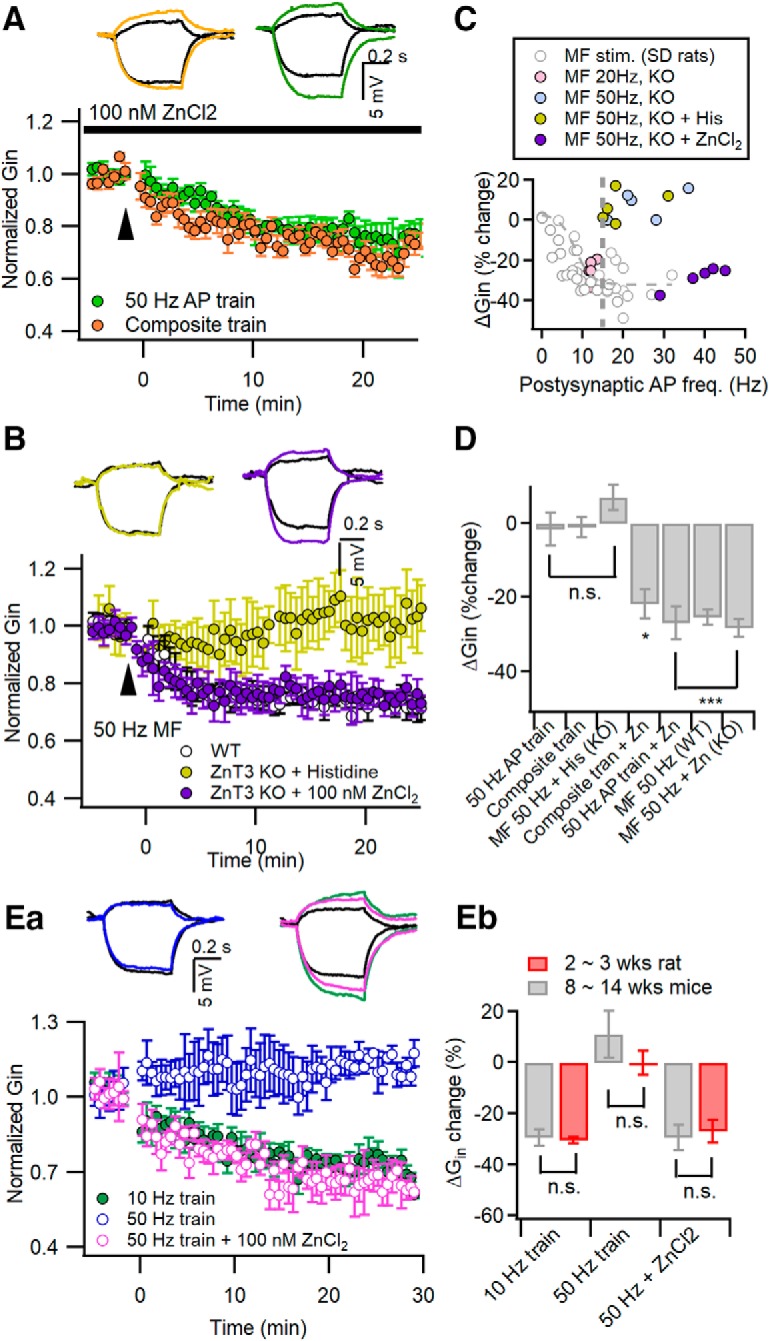Figure 6.

Supplement of Zn2+ to extracellular solution disinhibits the induction of LTP-IE upon inadequate stimulation. A, Supplement of 100 nm ZnCl2 in the extracellular solution enabled the composite train (orange) and 50 Hz AP train (green) to induce LTP-IE. Insets, Representative traces for Gin before (black) and 25 min after conditioning (the same color codes as the main panel). B, MF stimulation at 50 Hz for 1 s readily induced LTP-IE in CA3-PCs of ZnT3KO mice in the presence of 100 nm ZnCl2 in bathing solution (purple). Histidine alone did not allow 50 Hz MF stimulation to induce LTP-IE in CA3-PCs of ZnT3KO mice (yellow). The extent of ΔGin in ZnT3KO was not different from that in WT as control (open circles, reproduced from Fig. 4Aa). Insets, Representative subthreshold voltage responses before (black) and 25 min after conditioning. C, Plot of 50 Hz MF stimulation-induced ΔGin (purple) as a function of the number of postsynaptic APs in ZnT3-KO CA3-PCs with 100 nm ZnCl2 added to the bathing solution. For comparison, data for ΔGin induced by 20 or 50 Hz MF stimulation in KO CA3-PCs and in Sprague Dawley rats are reproduced from Figures 5B and 4D (gray symbols), respectively. Note that the nadir on the plot occurred around the postsynaptic AP frequency at 10 Hz for MF-induced ΔGin in KO CA3-PCs, but supplement of ZnCl2 converted their relationship similar manner as those of Sprague Dawley rats. D, Summary for the mean values of ΔGin induced by conditioning, as indicated on the abscissa. The control values (ΔGin values under the conditions without Zn2+ supplement) are reproduced from Hyun et al. (2013) (for 50 Hz AP train), Figure 2C (for composite train), and Figure 5A (for 50 MF stimulation in WT). Ea, Experiments similar to those in Aa were replicated in CA3-PCs from 8- to 14-week-old mice. LTP-IE was readily induced by 10 Hz somatic AP trains (green) but not by the 50 Hz AP train (blue). With 100 nm Zn2+ supplemented to aCSF, LTP-IE was induced by the 50 Hz AP train (purple). Eb, Mean values for the extent of ΔGin were not different between 2- to 3-week-old rats (red) and 8- to 14-week-old mice (gray) for each condition. n.s., No statistical significance. *p < 0.05; ***p < 0.005.
